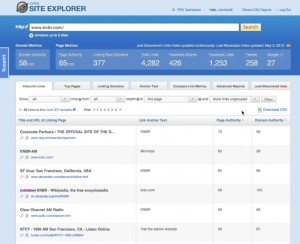By John Thyfault, Vice President of Search & Social Strategy, Beasley Direct Marketing

Organic Links Overview
In an earlier blog post (“How To Improve Organic Search with Link Building”), we discussed how Google assigns value (PageRank) to your online material. Also covered was what Google views as natural or artificial link building. In this post, we examine some best practices for building those links in an organic and Google-friendly manner.
Best Practices
When you are developing links, there are some finer points you need to know. The anchor text for inbound links should not be the same. Google regards identical anchor text as mechanical link building, which means these links will be discounted. Have several target pages with interesting content. As always when creating any sort of outbound communications, keep SEO principles in mind. Furthermore, come up with phrases you would like to appear on a search engine and that best describe their target pages.
Press releases are the exception to this rule. Google has figured out that press releases are distributed widely, all with the same anchor text in key links. They also know that press releases often are picked up and used as-is. So, the identical linking verbiage will appear everywhere the press release appears. Google does not discount these links if they derive from a press release.
Best Place for Links
The best place to get valuable links going is social media. However, Google’s scheme for valuing these links is not straightforward. Social media links are transient in nature, easily drowned out by other conversations. To effectively take advantage of social media as a link-building mechanism, you must hold a continued conversation around your product or service. And, while still offering value in other aspects of the discussion.
Leaving comments on blogs does nothing for your PageRank. The reason is many people have abused this means of creating links in the past. The primary link, the link you put out in your blog post is generally coded as a “nofollow,” link. A “nofollow” link tells Google and the other search engines not to follow the link or to include it in the Google database. As such, these links are not assigned any value. However, when someone re-Tweets the link or shares it via a blog post (not a comment) Google will notice these secondary and tertiary links. Google then begins to assign value to them.
Link Building Tools
Use link-building tools like Moz.com’s Open Site Explorer or MajesticSEO.com. These tools identify and assess the value of new sites and authors from whom you are hoping to get a link. Both of these tools will help you to analyze your site’s current in-bound link profile. The tools also compare your profile to your top competitors, and identify sites and authors that you can target to build new links.
How to Build a List of Targets for Links
Approach building a list of targets in a step-by-step process:
- Run a report on your domain and on the top pages within your domain to which you want to drive traffic and links.
- Run the same report on your top competitors in the search results.
- Compare the reports for overlap and look for areas that do not currently link to your site.
- Look at the different metrics that the tools supply (“Citation Flow” and “Trust Flow” on MajesticSEO (see Figure 1) and “Page Authority” and “Domain Authority” on Open Site Explorer (see Figure 2).
- Look at the total number of backlinks to each of the domains you are researching. Also, look at the total number of referring domains as well. The combination of these two metrics combined with the “Flow/Authority” metrics above will allow you to understand which sites are viewed by Google and the other engines as having quality and authority. The higher the authority a site has, the more value a link from it is.
- Create a unique approach to each site that you are targeting. Come up with a compelling reason that a link to your site will benefit the users of your target site. Give them a business reason to take the time and effort to create a link.
- Try to identify individuals at the sites that you are targeting and address them directly.
- Dedicate enough time to the process to get results. It takes a fair number of touches to get a new link and it does not generally happen overnight. Three to six months of consistent work on link building is generally required to be successful.
- Use existing outreach to build links in the meantime. Make sure your site is publishing valuable information on a regular basis. Also, make sure to include a link back to the relevant page on your site in every outbound communication.
…And,…,
Figure 1: Link Analytics Tools To Help Assess Value of Links—MajesticSEO.com

Source: MajesticSEO.com
Figure 2: Link Analytics Tools To Help Assess Value of Links—Moz.com’s Open Link Explorer

Source: Moz.com
More Details to Know About Links
Something to keep in mind. Google and the other search engines look at some of the more technical details when assessing the value of a new inbound link. Remember, take a look at the IP addresses of the inbound link targets for your site. Google looks at the “C-Block” in IP addresses to try and catch poor-quality link networks that try to trick the engines. The C-block is the third set of numbers in an IP address, i.e., 234.123.888.334. If a large number of your new links are coming from the same C-block, Google looks on this as an attempt to game the system. Your site will be devalued. In the above example, too many links coming from the “888” C-block will be viewed as spam. But if they are coming from both the “888” and the “887” C-blocks, Google views this as more natural. There are exceptions to this rule. If the links are coming from a highly rated and trusted site such as The Wall Street Journal, Google will give them the green light.
Finally, scrutinize the links to your site from other parties. Are they overly promotional? Are they offering something that seems too good to be true? Get rid of them. Some fairly large companies have gotten into difficulties with Google for allowing poor-quality inbound links. Google has a link disavow tool in the Webmaster’s Tools that it offers to site owners. Use this tool VERY judiciously. It is a permanent and radical solution that can have unintended consequences if you are not sure that the link is hurting your site.
About the Author
* * * *
This post was authored by John Thyfault, Vice President of Search & Social Strategy, of Beasley Direct Marketing. Contact John at jthyfault@beasleydirect.com.
John has more than 18 years of marketing, sales and product development experience, and he brings a proven track record of successful campaign, program and product development expertise. His knowledge of search engine optimization and marketing, combined with an in-depth understanding of customer identification, market analysis and segmentation, allows him to deliver high returns on our client’s marketing investment for both business-to-consumer and business-to-business markets.
Prior to working with Beasley Direct, John was Senior Client Services Project Director at ThirdAge.com, a first wave baby boomer lifestyle and community website. At ThirdAge he successfully led major client sponsorships for Fortune 100 companies in healthcare (Tylenol), financial services (American Century), technology (Intel & IBM) and consumer products areas (Revlon & Viactive). He was responsible for strategic and tactical goal setting, project management, new product creation and web site production. John previously worked in Channel Marketing and National Account Sales for IDG Books Worldwide, the publishers of the immensely popular “…For Dummies” book series. Additionally, he managed the wholesale distributor sales channel for Tor/Forge Books, an imprint of St. Martin’s Press.
John is active in local marketing associations, including the Direct Marketing Association, the Business Marketing Association and is currently serving on the board of directors for the Silicon Valley American Marketing Association.
John has taught search engine marketing fundamentals extensively. He has led workshops for the Silicon Valley American Marketing Association, Northern California Direct Marketing Association (DMAnc.org) and the Business Marketing Association. He also teaches Search Engine Marketing at UCSC’s Extension in Silicon Valley.


Good post shared i really need this post.
Very informative post. Great break down on google metrics.
Thanks for recommending these tools. I have found that iBusiness Promoter is also excellent, but it’s more for local SEO. For national or global campaigns SEOMoz is probably the best bet.